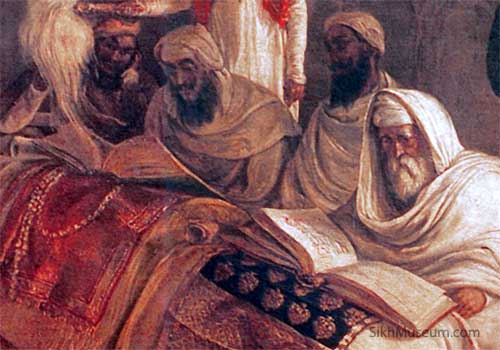Painting Details

Schoefft's painting depicts two volumes on separate alters open in front of Maharaja Ranjit Singh. In order to paint this scene, Schoefft must have witnessed a similar scene either at Lahore or Amritsar during Maharaja Sher Singhs reign which he then used as the basis for his imaginary depiction of Maharaja Ranjit Singh at Darbar Sahib.
At first glance it appears that one of the scriptures in the painting is the Guru Granth Sahib while the other must be the Dasam Granth. The Dasam Granth is a secondary Sikh scripture often seen on similar dual alters with the Guru Granth Sahib at places of worship managed by the Nihang sect. John Malcolm mentioned a general gathering of Sikh chiefs at Amritsar in 1805 convened by the Nihangs where they used such a dual alter as they officiated over the religious activities during the gathering.
Acalis [Nihangs], or immortals, who under the double character of fanatic priests and desperate soldiers, have usurped the sole direction of all religious affairs at Amritsar, and are, consequently, leading men in the council which is held at that sacred place...The assembly, which is called the Guru-mata, is convened by the Acalis [Nihangs]...When the chiefs and principal leaders are seated, the Adi-Grant'h and Dasama Padshah ke Grant'h are placed before them. They all bend their heads before these scriptures, and exclaim, Wa! Guruji ka Khalsa! Wa! Guruji ki Fateh!..The Acalis, when the prayers are finished, desire the council to be seated.
Sketch of the Sikhs
John Malcolm, London 1812
Both the Guru Granth Sahib (1430 pages) and the Dasam Granth (1428 pages, standardized) are very large volumes of a comparable size. In Schoefft’s painting one can see a dramatic difference in the number of pages between the two books. The book on the left alter in the painting is very thick with a large number of pages while the book on the right alter is very thin with substantially less number of pages.
As there is no Sikh scripture that has three times as many pages as the Guru Granth Sahib, it appears that the thicker volume shown on the left alter in the painting is the Guru Granth Sahib. The identity of the much thinner volume on the right alter given its reduced number of pages is likely a volume containing the hymns used for daily prayers by Sikhs. Such texts are commonly referred to as a Nitnem Gutka or Pothi.
